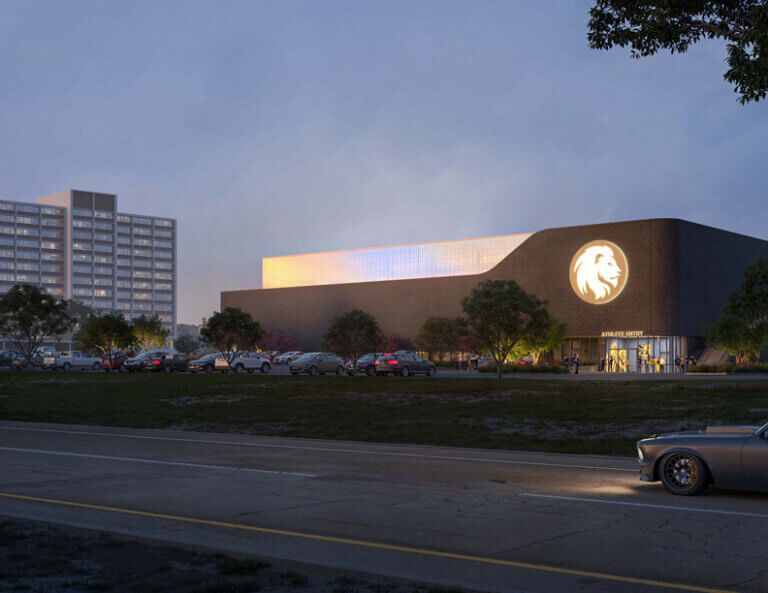
This article originally appeared on Construction Executive.
By Chris Potter
Oftentimes, higher-education construction projects see a lack of alignment between general contractors, design teams and additional trade partners that can hinder their successful delivery on time and within budget. There are certain aspects of planning, project control and team performance that are vital to ensuring success within a higher-education project, as this sector presents a unique set of challenges that are tacked on top of the universal issues all jobsites are facing with supply-chain issues and price hikes. Colleges and universities follow strict academic calendars and set budgets years in advance, so any amount of instability and volatility can be detrimental to a project’s success.
Every project will likely run into some amount of unforeseen uncertainty, whether it’s a design error or a weather event, but these can be greatly reduced by three things: BIM technology, early collaboration and the early procurement of materials. By leaning on time-tested preconstruction strategies, university decision makers and general contractors will be able to ensure projects deliver on time and stay within budget regardless of market volatility. Here is a deeper look at the three key methods that can provide certainty in projects during unprecedented times in our industry.
1. UTILIZE BIM AND ITS LONG-TERM BENEFITS WITH CLIENTS
Contractors should take advantage of the many benefits of building information modeling (BIM) technology to successfully navigate the challenges that higher-education projects typically present. For example, Hoar Construction was contracted to construct the new lecture hall for Samford University’s Brock School of Business in order to keep up with the school’s flourishing student population. During the preconstruction phase, Hoar discovered that the project was over budget by $3 million—and the school needed to present the project to the board of trustees after Thanksgiving holiday, in less than a week.
By using BIM to study and analyze every aspect of the virtual model, Hoar and Samford were able to cut costs down by more than 20%, mutually agreeing on a vision that minimized the likelihood of having to make time-consuming and costly changes after construction began. Conclusively, the project was presented to the board on time, and Hoar’s success with BIM has created a long-standing relationship with Samford University, resulting in the completion of 40 projects across the campus during the past seven years.
2. ENGAGE WITH TRADE PARTNERS EARLY TO CREATE A CLEARER PATH FOR ALL
Early collaboration among trade partners and design teams is key to creating a realistic plan for the flow of work and minimizing the chance of project delays. With higher-ed projects, schedules are typically tighter than those of other sectors due to the need to align with the school year. Finding trade partners earlier in the planning phase promotes more accountability, allows more time for feedback before initial construction work begins and maximizes value for the client.
This success is evident in our work on the new Christ the King Chapel at Christendom College, built to accommodate 840 people with more space for worship. During the preconstruction phase, our team identified path tasks that would save time in the schedule, creating room for more flexibility for added scope or unforeseen changes. One of those path tasks included early collaboration with our steel trade partner to produce CAD drawings, so our concrete trade partner could develop their own CAD drawings based on the steel requirements. After initial collaboration, we hired a third-party surveying crew to review both sets of drawings to ensure that there were zero discrepancies. Through early collaboration and intensive planning, the concrete was poured and the steel was erected efficiently, resulting in the project moving three weeks ahead of schedule at the early stages of construction and completing six weeks early.
3. SECURE MATERIALS EARLY TO AVOID CONSEQUENTIAL PRICE HIKES
There is no such thing as too early. The current state of the market remains unpredictable, but to better navigate these obstacles, contractors should meet with engineers and builders at the onset of a project, so team members can vet and evaluate all design documents. This will provide strong clarity on specific materials that will be needed along with ample leeway for any adjustments that may occur, so team members can lock in prices and accelerate the delivery of materials.
For example, during the construction of Moody Coliseum for Abilene Christian University, the construction team identified long steel lead times and the continuously rising cost of steel as major threats to the budget and project schedule. Typically, the structural engineers would finalize the structural design documents, send them to the structural steel trade partner to detail and then order the steel. However, the construction team developed a different strategy to engage both the engineer and the steel trade partners to create thorough design documents in real time, expediting the procurement and delivery of steel by six weeks and saving the client more than $400,000.
Analysts are expecting the market to remain unstable in 2023. To build certainty into higher-education projects, general contractors must remain adaptable and implement these strategic measures to stay on top of the inevitable ebbs and flows that will impact the overall environment. Project teams that utilize these methods will have the upper hand and continue to generate meaningful results on college and university campuses across the country.

